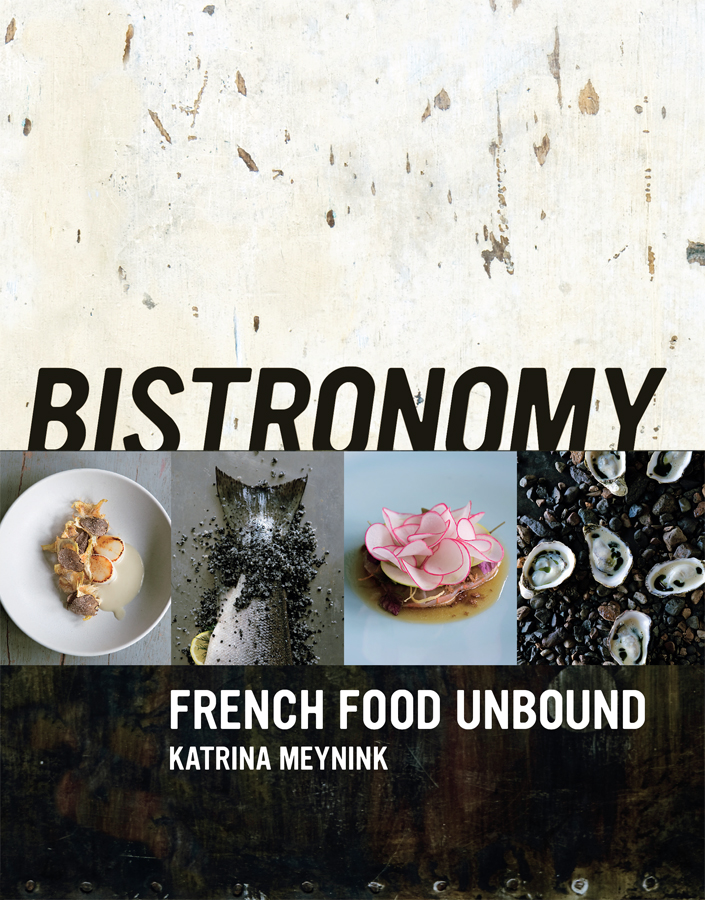AMUSE-BOUCHE
This book lives because of Julia Child. And it breathes because of the generous chefs who inhabit its pages.
In 2012, I applied for a Julia Child grant through the Culinary Institute of America. I pondered the idea of bistronomy that elusive partnership of gastronomic excellence in the comfortable, relaxed atmosphere of a bistro and what it meant in terms of Julias love of French gastronomy and her absolute ideals of sharing food around the table. Somewhere, somehow the culinary gods were on my side. I received the grant, packed my bags and headed to Paris. I ate, I talked to chefs, I discovered. Then I did it all again. And again, for good measure.
What fascinated me were the glimpses of wine bars in alleyways, forgotten corner shops turned restaurants, and the attraction of nameless locales as tiny hubs of food and wine. It wasnt dining in Paris. The formality, the sense of pomp and circumstance of eating in restaurants the sort of constipated churches of haute cuisine where good conversations go to die suddenly seemed peripheral to this new style of dining: top-notch cooking prepared with a haute cuisine touch and served in fun, relaxed surrounds. It was enthralling to feel the undercurrents of culinary revolt; that sticking it to the man mentality that continues to bubble deliciously, and ever so subtly, under everything these chefs are doing.
The meals. Holy hell, the meals. They were so good. Gutsy. Honest. Often unexpected. Food that ranged from the beautifully sophisticated to dishes as homely as a dent in the couch. Dishes as decorative as modern art and as neckable as a packet of chips. And I could actually afford to eat them, even more than once. I cannot ever remember consuming food that prompted so many actual, physical responses. My face pursed like a cats bum at the sharp kick of fresh, pungent horseradish grated over a gloriously marbled wagyu rump cooked on coal, or the unexpected sourness of a citrus sherbet and whey ice-cream dessert. There were groans of horny delight at a light-as-air waffle with artichoke-heart cream whipped into submission and topped with delicate shavings of jambon, before murmuring over and prodding a duck dish that was earthy, piquant, meaty, wobbly, crunchy and fatty all those textures in a few mere mouthfuls all before eating the sort of thick, indulgent and creamy rice pudding that I had only ever dreamed of. To watch me was probably indecent, but here I was suddenly experiencing the holy grail of food in the city Id read about as a culinary student and the city Id dreamed about as a romantic waiting to be swept off my feet. I would never be full.
I immersed myself in the restaurants and wine bars, eating everything, picking dishes apart, making notes and taking photographs, trying to absorb as much of the culinary energy of these chefs and their spaces as I possibly could to share in this book. I turned my search further afield, and discovered more and more chefs and restaurants across the globe are embracing this way of cooking and eating.
Lets be clear: this tome is not about capturing a trend. It would be ignorant not to acknowledge that this style of dining has and still is returning France to the culinary map, after witnessing her decade of suffering as the rest of the gastronomically attuned world followed the foamista chefs to Spain, went foraging with the bearded boy scouts in the Nordic regions and digested everything nose-to-tail on Fergus Hendersons coat-tails through Britain.


This is first and foremost a celebration of food, of the people who grow it, the people who cook it and the people who eat it. Some of the chefs on the following pages are doing family-style food, some are doing super-high-end intellectual food while others are still very produce-and-tweezer driven. The collection of chefs and restaurants are those I feel tell the story of where excellence in bistronomy may be found. It is by no means an exhaustive survey. It is about who is interesting, who has a unique voice, and ultimately who is really owning what they are doing within a bistronomy-style setting.
This book is simply an attempt to capture the sensory light and shade of this elusive thing called bistronomy. So what you hold in your hands is a collection of moments, cleaved into parts, not an autopsy performed by some kind of culinary oracle, as I dare say there is plenty more to come in the bistronomy story
Katrina Meynink
TASTING NOTES
6 things I should point out ...
| 1. | Cooking these recipes, like the bistronomy dining experience itself, can be rough, unrefined, beautiful and occasionally painful. The food is not designed by committee so it varies from the accessible to the aspirational. |
| 2. | This is not an attempt to answer the who, what, where, why, how and will it last mysteries of bistronomy: it is merely a few lucidly pointed fingers, signposts if you will to the phenomenal success of this style of dining and its greatest global ambassadors the chefs, the producers, and you, the willing eater. |
| 3. | This book is a celebration of flavours. Off-the-wall combinations, reinterpretations of the classics, the joy found in the simple and the challenge of the complex. It is a chance to sniff out what these chefs are doing and how they make the food taste so amazing. The menus at bistronomy restaurants change. Constantly. So these recipes are, for the most part, fleeting tastes of what the chefs can do, and a chance for you to try them at home. |
| 4. | Sometimes, a restaurant, chef or recipe has been included within these pages that may not fit your perception of what bistronomy is; but sometimes there is food, an ambience, or a chefs spirit that defies description. It is for everyone, but it doesnt aim to please all comers. |
| 5. | Dont be afraid to cook. Ingredients and chefs like to misbehave, so they make epic bedfellows. The wonderful thing about cooking is that mistakes are usually very short lived. So enjoy your cooking, pass your pleasure to the table, and discover that the food is likely to be far less rebellious when accompanied by love and wine. |


















